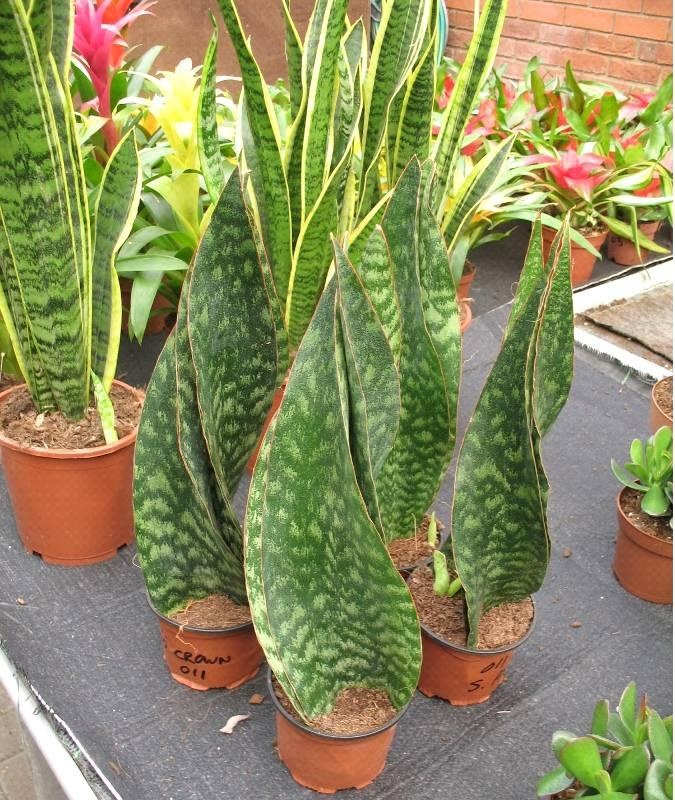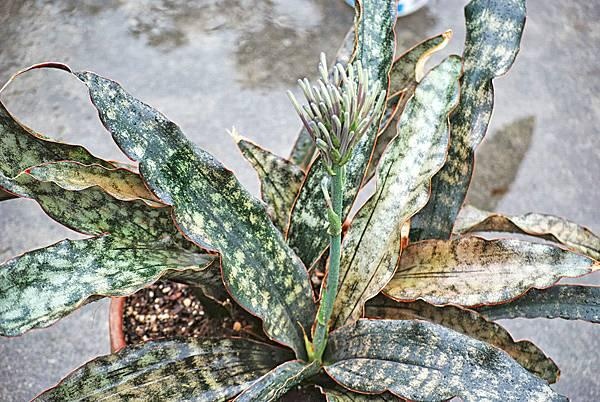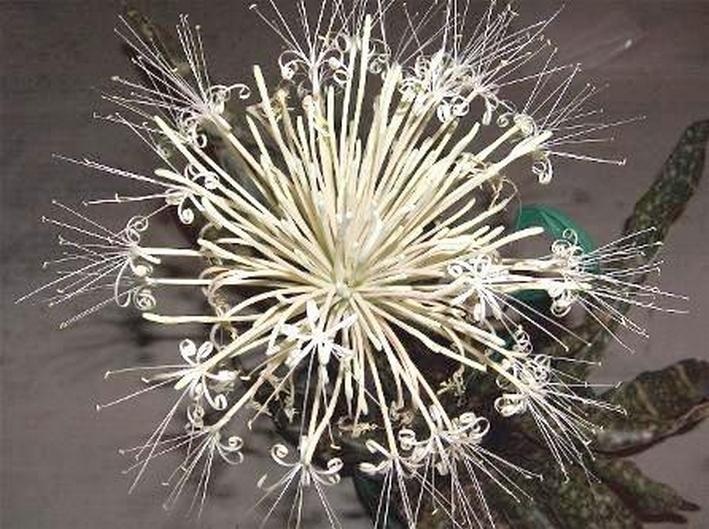Home care
Consider the main parameters of the development of Sansevieria Velvet touch:
- Temperature. In the spring-summer period - 20-27 ° С, in the autumn-winter period - 15-22 ° С.
- Watering. Recommended in moderation, once a week on average. Stagnation of water in the soil and the base of the pot is not desirable. Spraying the flower is carried out only in the spring and summer. Water for irrigation is used purified and settled or rainwater, its temperature is 18-20 ° C. When watering and spraying, water should not get into the leaf axils.
- Light. Should be quite bright, but diffuse. The flower pot is best placed on the east or west side of the house. If located on the south window, it should be shaded with a curtain.
- Priming. The soil must be nutritious, loose, drainage is required. The best composition necessary for the development and growth of Sansevieria Velvet touch is a combination of the following components:
- turf - 1 part;
- loosened soil - 1/2 part;
- sand - 1/2 part;
- humus - 1/2 part;
- crushed peat - 1/2 part;
- drainage.
Expanded clay, small-diameter pebbles, sand and clay shards are suitable as drainage.
- Pruning. It is carried out on adult flowers in the spring during the transplantation period. The juice secreted by the leaves of the plant is poisonous, since the plant is capable of absorbing toxic substances, therefore it is recommended to work with gloves.
First, the dried and decayed parts of the root system are trimmed, and the cut sites are treated with phytosporin or activated carbon powder. For grafting, undamaged leaves can also be removed along with the whole root.
- Top dressing. It is advisable to use ready-made commercial feedings for cacti in a breeding 2 times less than indicated on the package.
- Pot. The preference is given to the view, wide in diameter, but not very deep. Material - thick-walled ceramic with drainage holes.
- Transfer. Young plants are transplanted in early spring 1 time in 1.5-2 years, adult flowers - 1 time in 3-4 years.
To do this, the entire bush with an earthen clod must be removed from the pot, removing the old soil before reaching the roots and cutting off the dry root processes. Pour drainage material into a new pot and add a layer of ready-made soil two fingers high. The plant is placed in the middle of the pot, the remaining space is filled with the rest of the soil. The soil is lightly tamped and watered.
- Wintering. Lasts from November to early March. Watering is reduced and carried out approximately - once every 3 weeks. Top dressing is not used. Leaves are not irrigated with water, only wiped with a damp cloth.
Beautifully blooming forms
In their natural environment, sansevieria bloom regularly. Flowering is short (5-7 days) and has several features:
-
the buds open only in the dark and are fragrant;
-
the leaf rosette forms a peduncle only once, after which it stops growing and gradually dies off.
The flowering of most species is inconspicuous and significantly inferior in its decorativeness to the leaves. However, not everything is clear here either: several species are rightfully considered to be beautifully flowering. This applies to varieties of Hyacinth Saneviera and Kirki.
Sansevieria Hyacinth
A species with a strong rhizome and small (2-4 leaves) rosettes, dark green, in spots or stripes of V-shaped leaves half a meter long, slightly widened in the central part and tapering at the base. An obligatory color element is the edging, the color of which varies from red-orange to milky-white tones.

Varieties of Hyacinth Sansevieria bloom in winter, releasing a long (0.7 m) strong peduncle topped with a panicle of small fragrant buds. The shape and aroma of the inflorescence resembles a hyacinth.
One of the most beautiful hyacinth sansevieria hybrids is the Ayo variety. It is distinguished by elongated and rounded at the base leaves of half a meter in height, covered with silvery-gray fuzzy spots and a thin orange edging.

Pickaxes
The species is named after the British consul and collector D. Kirke. Kirka's leaves are collected in rosettes of 5-15 pieces and resemble hard ruffles, painted green or pinkish-brown, with small whitish specks, tone.

Pickaxes bloom, forming large inflorescence umbrellas of graceful white buds adorned with intricate curls of stamens. Against the background of green leaves, the snow-white inflorescences of the Pickaxe are like stars against a dark background of the sky. This explains the origin of the unofficial name of the variety - "Star".

The species has several varieties, the most interesting are:
-
pickaxes Lovely with brownish-red leaves;
-
Pickaxes Friends with compact dense rosettes of narrow (1-2.5 cm) long leaves;
-
picks Silver Blue, a rare and slow-growing miniature variety with a rosette of dense spotted leaves-ruffles of blue, with a silver coating, shade.
Landing
The container for planting Sansevieria Hanni should be ceramic, wide and shallow, corresponding to the dimensions of the plant. You can be guided by this ratio: the diameter of the pot is twice its height. There must be a drainage hole in the bottom.
At the bottom of the planting tank, a drainage layer must be laid: small pebbles, expanded clay, brick battle with pieces of charcoal. This layer should be the thicker the younger the plant is and can fill up to a third of the pot's volume.
When planting, they pay special attention to the safety of the root system, trying to preserve the earthen lump. Transfer
Transfer
Hanni sansevierias are transplanted in the spring, in March-April. The signal for transplanting is the complete entanglement of the earth with roots. Young plants give such a "signal" annually, while more mature ones - once every 2-3 years.
Before transplanting, watering is stopped, planted in moist soil and after transplanting it is not watered immediately.
In summer, it is enough to water Sansevieria Hanni once a week, and in winter - once a month. This is exactly the case when it is better to dry than to overmoisten.
They especially protect deciduous trees from irrigation water: stagnation of moisture in it leads to root rot, which will destroy the plant.
The air is preferable dry, spraying is not necessary, you should only periodically wipe the dust from the leaves.
Top dressing
During the period of active growth of sansevieria, in the spring and summer, once every two weeks, fertilizing is carried out with a specialized mixture for cacti and succulents.
If complex fertilizers are used, it must be taken into account that they should not contain an excess of nitrogenous compounds and this complex must be dissolved in a much larger amount of water than for other plants.
Pruning
This operation is applied only to damaged leaves. They, as a rule, dry out and then such an area should be cut off, leaving a narrow dry border so that the process stops.
Bloom
Sansevieria Hanni can bloom at any time of the year - star-shaped small flowers on an elegant peduncle. This peduncle must be cut off at the end of flowering.
To induce the plant to bloom, it is transplanted into a cramped pot, only 4-5 cm wider than the previous one.
Growing conditions for rosette sanseviers
Like all her relatives, Khan's sansevieria became famous for its unpretentiousness. It grows well alone and in compositions, it puts up with almost any conditions in living rooms and does not make so many demands on lighting and temperatures.
Lighting and placement
It is very simple to choose comfortable lighting for this type of sansevieria.Sansevieria Khan is not afraid of shading, even quite strong, but its shade tolerance does not manifest itself with a sharp change in lighting: the ability not to lose decorativeness is characteristic of a plant only with a gradual decrease in illumination.
The stronger the shading, the less pronounced the bright patterns of variegated varieties, the lighter the tone of the leaves (especially young ones) in the rosettes. And the slower the growth of the outlets themselves. But even in deep shadow, deforming and almost stopping in development, Khan's sansevieria will not die.
This type of sansevieria can lose stripes even in a too bright sunny place. Diffused bright light most fully reveals both the propensity for rapid growth, and the beauty of the patterns on the leaves, and the intense base color. Only new varieties with very wide stripes on the leaves are not afraid of direct sunlight and prefer sunlight rather than diffused lighting.
In winter, for all rosette-type sansevierias, it is better to increase the lighting by rearranging them to the brightest places (especially if the temperatures remain the same.
The southern windowsills are not the best place for Khan's sansevieria. In too hot places and under the scorching sun, even this super-hardy plant can dry out the tips of the leaves, not to mention the tarnishing of colors. The eastern and western windowsills are considered an ideal place for Khan's sansevieria. When placed inside the interior, it is better to stay within light, semi-shaded areas.
When growing Khan's sansevieria, especially in separate containers, and not in compositions, it is worth remembering that the plant is sun-dependent and for the uniform development of outlets it must be periodically turned in relation to the light source.
Sansevieria Khan is great for planting with other indoor crops as a shading or complementary plant. It is very often planted together with long-leaved sansevieria, surrounding them with neat rosettes and creating lush compositions.
But Khan's sansevieria can be added to more complex groups not only with succulents. The only thing worth considering is the nature of her growth. After all, the plant is actively releasing babies, "closes" into a continuous spot from the sockets and can suppress the main plants.
Description of the plant
This flower in the common people is called "pike tail", or "mother-in-law's tongue", "cuckoo's tail", "devil's tongue", and you can also find many other names. More than sixty varieties of this plant have been bred, but only a few of them are most common in home pots.
The flower does not require special care, it can even be without watering for quite a long time. In addition, it is believed that it is the "mother-in-law's tongue" that is one of the plants in which the production of oxygen is considered to be maximum. Culture looks great in any interior, it is absolutely safe for children and pets.
Sansevieria belongs to the agave family. The plant is characterized by thick long leaves of various colors.
The flower originates from savannas and subtropics. The ideal climate for him is in Asia, Madagascar, India, as well as in the countries of Central Africa. That is why we only grow this plant in pots. In the open field, the culture simply will not survive, even in spite of its unpretentiousness.
Sansevieria leaves are thick, have a rather dense structure, and look like a gloss. As for the colors, there are a huge number of them, depending on the type of plant. Mostly these are green and brown shades with a different number of stripes, and can also be interspersed.
The length of the leaves reaches one meter. They are often slightly pointed at the ends. The arrangement of the plates is also significantly different. Leaves can be either in a vertical, horizontal direction, or look to the sides.
Sansevieria flowers are green and white. Their petals are rather narrow and have long stamens. The peduncle grows very tall, and there are gorgeous inflorescences on it.The aroma during flowering is simply divine, a bit like the smell of vanilla. Most of the buds open in the afternoon, and at night you can fully enjoy the excellent aromas. Unfortunately, when grown indoors, fruiting of this plant almost never occurs.


